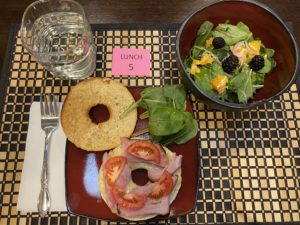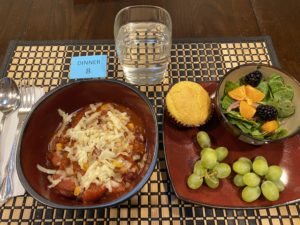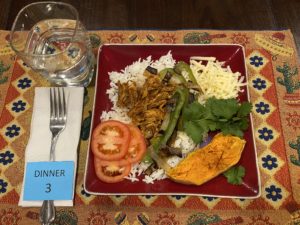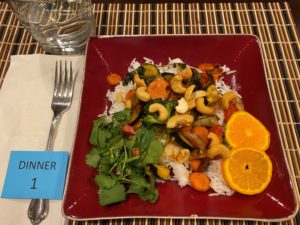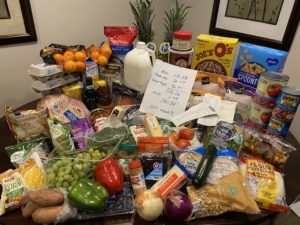Americans have been asked to stay home from work, school, and other gathering places for an indefinite period during the current pandemic. Many have stocked up on items they want to have on hand. One photographer documented shoppers’ selections over the past weekend, capturing carts full of chips, soda, ramen noodles, frozen entrees, and disinfectant spray. Shoppers told him the items weren’t much different from what they usually buy, while also admitting they were indeed feeling a bit nervous.
I returned home last Friday evening after being away for over a week. A national state of emergency had been declared and local school districts just announced they would be closed for at least 3 weeks. Shoppers had already rushed to grocery stores and my refrigerator was nearly empty.
My “normal” approach to grocery shopping is to plan all the items I will purchase in advance and use a simple spreadsheet to estimate the total cost. Since January 2018, my grocery budget has been a strict $1.50 per meal per person, and my meals at home have followed MyPlate guidelines. However, when I saw the bare bread and produce shelves, I knew my planned grocery list would be of little good.
Stretching your Food Budget, Even in Uncertain Times
Because many store shelves were bare, I stopped at three different stores that night. I chose basics that align with tips from Cooking Matters for stocking your kitchen.
COOKING MATTERS TIPS (in bold)… and WHAT I BOUGHT
- Whole Grains (and other grains): Old fashioned oats, corn muffin mix, bagel rounds, Italian bread loaf (2), flour tortillas, macaroni and cheese (organic), radiatore pasta, and Basmati rice.
- Beans (and Legumes): Organic peanut butter, organic peanut butter with flax and chia, and kidney beans (3 cans).
- Fruits and Vegetables: Fresh–Green grapes, organic mixed greens, tomatoes, broccoli, green pepper, red pepper, zucchini, Roma tomatoes, yellow onion, red onion, mandarins (2 bags), pineapples (2), blueberries, blackberries; Frozen–mixed vegetables (2 pkg), green beans (organic), Brussels sprouts, mango (2 pkg), mixed berries, peas (2 pkg), corn; Canned–tomatoes (3 cans).
- Fish: Sockeye salmon
- Nuts: Cashews
- Whole-grain, low-sugar cereals: Whole grain cereals (2 large boxes), granola (organic)
- Condiments and dressings: Tikka masala sauce, marinara sauce
- Herbs and spices: Fresh cilantro, cinnamon
- Healthy fats (and proteins): Sicilian extra virgin olive oil, turkey pepperoni, cheddar cheese, pepper jack cheese, Parmesan cheese (wedge), 2% milk (1 gallon), eggs (2 dozen)
- Basic baking items: Honey (for making granola)
Remaining items I purchased: Spiral sliced ham (>10 lbs.), bratwurst, French roast coffee
Keeping in mind suggestions from MyPlate.gov also helped:
- know how much you need
- take time to enjoy smaller amounts of food (eat less!)
- choose quality dairy foods
- drink water instead of sweetened beverages, and,
- (almost always) make half your plate fruits and vegetables
The 2015-2020 Dietary Guidelines for Americans identify items to limit or avoid altogether. Notice the items I did NOT buy: convenience foods, frozen entrees, hot dogs, chips, crackers, desserts, and sweetened beverages.
Food for Three Weeks at Home
Below is a picture of all the food I purchased to stock my kitchen for 3 weeks for 2 adults, recognizing there were a few things in my cupboard already (rice, quinoa, spices, etc.). These groceries cost $178. Add in about $2.50 for buying an additional gallon of milk in a week or so, and it totals $180.50. If these items stretch to provide 120 meals (20 days, 3 meals/day for 2 adults), that comes out to $1.50 per meal. Even if I was to spend $59 more, (for a grand total of $240) it would still only come out to $2/meal for the 120 meals.
While You’re at Home, Become a Better Cook
Embrace this opportunity to eat at home, which allows you to limit costs and to control what you are eating. MyPlate.gov recommends becoming a better cook by trying out healthier recipes that use less solid fat, salt, and sugar. Ohio’s own “Celebrate Your Plate” website offers many helpful ideas for shopping for and cooking healthy meals on a budget. Here are videos that demonstrate some easy cooking techniques.
I recently met a group of teens who sell vegetables they grow at a farmer’s market. They said that whenever someone asks how to cook a certain vegetable, they say “stir-fry it or roast it”. That is sage advice. I will stir-fry or roast most the vegetables I bought, put them atop of rice or pasta, add seasoning or sauce, and savor many easy, delicious, healthy, low-cost meals.
Below are a few of the meals we have enjoyed since hunkering down last weekend. What new meals will you try during your extended time at home?

